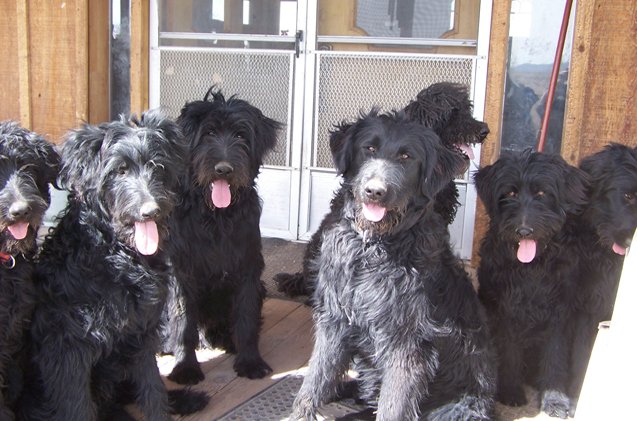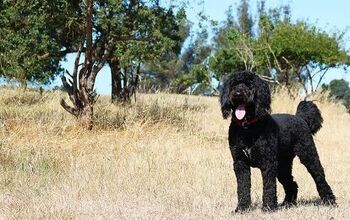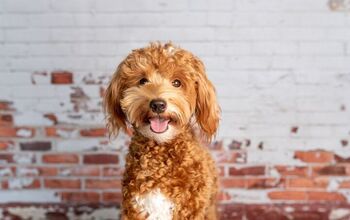Shepadoodle


About Shepadoodle
Shepadoodle Basics
It is a relatively new practice to intentionally create wholly new cross breeds by mixing two purebred dogs. This gave rise to the so-called designer dogs, whose popularity doesn’t seem to wane. The best designer dogs bring together two of the finest dog breeds around into one magnificent superdog that offers the best of both worlds. The Shepadoodle is one of these perfect hybrid pups and you can probably even guess its parentage purely from the name. This beautiful dog is a hybrid of two highly intelligent breeds – the German Shepherd and the Standard Poodle – making him inherently bright, easily trainable, and eager to please (aka everything that almost anyone would want in a family dog). The Shepadoodle has a ton of positive character traits: they are great with children, plus these charming and self-confident animals are known to become extremely loyal to their families. Because they are an alert breed it can take a while for them to warm to strangers but this makes them terrific watch/guard dogs. This is also a strong, energetic animal who requires daily exercise and can be prone to obesity and boredom when this doesn’t happen. Have you decided if the Shepadoodle is the dog for you yet? If not, keep your eyes glued to this page and scroll away. By the end of this article, we will reveal all there is to know about the Shepadoodle and you’ll know whether or not one of these gorgeous pups will be coming to your home.
The Shepadoodle is inherently bright, easily trainable, and eager to please.
Origin
It is often difficult to trace the exact origins of new designer dog breeds. Many often came about from experiments by breeders, and tracing their parentage down is challenging. For these dogs, however, the origins are a bit more clear. Shepadoodles originated in the U.S., as the US Army developed this breed in the 1960s as a military police dog. Because they come from two working breed dogs, they have an energetic disposition and need for regular and rigorous exercise. Of course, we know considerably more about the parent breeds of Shepadoodles, since they have been around for many years. Poodles were originally bred in Germany as a water-dog for hunting waterfowl while Shepherds were intended to herd sheep. It’s actually rare to know the exact origins of a hybrid dog, so even if these details aren’t exactly detailed, it’s still more than we know about most designer dogs.
Pedigree
Shepadoodles are a designer dog breed that has been bred to incorporate the intelligence of the German Shepherd with the non-shedding (and additional intelligence) of a Standard Poodle. As with many hybrid dogs, lineage may be skewed if one or both of the parents is not a purebred, but in fact another Shepadoodle. In this instance, you would have a mixed breed dog versus a designer dog. It’s a confusing distinction, but an important one. So, if you are looking for a proper designer dog Shepadoodle, you will have to look up its pedigree, or anything similar that the breeder can provide. A true Shepadoodle comes from the union of a German Shepherd and a Poodle – or, in other words, it is a first generation hybrid.
Food/Diet
While it’s best to keep your young pup on whatever dry food the breeder has started him on, you can slowly wean him over to your preferred dog food. An inherent trait from both breeds is slight gastric sensitivity and choosing a quality food is important. As an adult, your Shepadoodle should be fed 3-4 cups of top quality dry dog food daily. These dogs don’t over-consume and stay lean. This fact, combined with exercise, will contribute to their healthy life span.
If you are in any way concerned about your dog’s diet or want to make a major change to what you feed the pup, it’s always a good idea to consult your veterinarian first. While dog food manufacturers and pet blogs provide very useful feeding guidelines, they are still guidelines and not gospel. Every dog is different after all, and they all have their own needs. The only person qualified to determine the specific dietary needs of your personal pup is a vet. So always check with a vet before making any substantial changes to your dog’s diet to avoid any unfortunate problems down the road.
This hybrid was designed for service – the Shepadoodle responds extremely well to training and have uncanny natural instincts.
Training
Most designer dog breeds will pick up the very best character traits from their parents. This means that you will get a true hybrid dog that is intelligent, strong, and relatively healthy. The same goes for the Shepadoodle. This hybrid was designed for service and as a result, the Shepadoodle responds extremely well to training and they tend to have uncanny natural instincts. Because his lineage includes two very bright breeds, the Shepadoodle is a quick study and easy to train. They are a very active dog and respond well to a devoted and dominant pack leader, so it is recommended that training, socialization and discipline be introduced at a young age (it’s always important to take advantage of those early and impressionable days). It is also recommended that owners who are not familiar with training a larger dog defer to the experts and bring in a seasoned trainer to introduce the concept of dominance and discourage destructive behaviors early on. These dogs do exceptionally well in obedience and agility training. That said, it’s still important to always focus on positive reinforcement and reward-based training for the best results. Anything else is closer to abuse than training and will never yield the results that you seek.
Either way, there are several aspects related to the training process that you need to take into account. The foremost is the assertive stance that you need to adopt. Most dogs will be obedient towards an “alpha” character, in this case – you. Just be confident, determined, and adopt a commanding tone of voice. Besides this, you should arm yourself with patience (there’s no rushing these things), and with some treats as well. Always remember that positive reinforcement is key to successful training. Whenever your pet does a command well or is obedient, give them a tasty treat as reward. Harsh words and anger simply won’t achieve anything, and will make your pet fearful of you, only hampering the training process and your relationship further.
Weight
The weight and size of a dog can be important for a number of reasons. The Shepadoodle’s weight can vary depending on which parent dominates the gene pool. Typically he will weigh within 50 to 90 pounds but can sometimes go as high as 125 pounds. That’s a pretty dramatic difference and is due to the unpredictability of hybrids. It all comes down to which parental dog’s genes prove to be dominant in this regard.
Likewise, their activity levels and exercise needs might vary according to their size. A larger Shepadoodle might need more space and more exercise while a smaller one could do well with moderate activity. It all boils down to the individual litters, and requires just a tiny bit of adapting on your side.
Needless to say, these are pretty big canines – and in some cases can be considered large breed dogs. Of course, this will require adequate housing, as studio and small apartments simply won’t do for these big boys. Rather, consider having enough free space in your home for them to feel comfortable and to have free room to exercise and stretch. Of course, your pet will benefit most from a fenced-in yard where they can run and relax as much as they want. But if that is not an option for you, be sure to exercise them regularly in the park or elsewhere.
Temperament/Behavior
Boasting a relaxed basic nature, the Shepadoodle is loyal to its humans, so expect strong attachment. This is a well-mannered, warm and loving breed that is great with children and other pets (They love cats! Yes, that trait is possible in a dog). They are highly family oriented and while they need their outdoor space to work off boundless energy, they enjoy indoor time with their “pack”. Taking a cue from their German Shepherd lineage, they are also keen to please their leader and will respond well to instructions. Loving, loyal, playful, and well behaved, this is a delightful dog to have around any family.
Even so, it is highly advisable to do some early socialization and training in order to push the good nature of a Shepadoodle towards the front. While they are still in their puppy stages, these dogs need to be introduced to other dogs, new faces, and new children and people. That makes them more relaxed and more friendly towards them. Socialization is important for virtually every dog breed on the planet. Without it, a dog can become socially anxious, frightened, and aggressive. Of course, these issues can stem only in extreme cases, but still – socialization is important.
Common Health Problems
While typically a healthy breed, Shepadoodles can be prone to the same health issues as their parents, meaning hip dysplasia and Von Willebrand’s disorder (a blood disease that prohibits easy clotting) as well as prone to ticks and flea bites if their long hair is not properly groomed. As always, it’s very much worth maintaining regularly scheduled check ups with a veterinarian to ensure that any potential health issues are identified and treated as early as possible. Hip dysplasia is an inherited congenital issue, and sadly cannot be treated. It causes the hip joints to deteriorate, affecting your pet’s mobility and causing pain and discomfort. However, it is not such a major setback if it does happen in an unlikely case. Thanks to the great help from modern vets, this issue can be lived with.
Nevertheless, Shepadoodles are hardy and healthy dogs. Thanks to their sturdy frame and a robust health, they can turn out to be quite hardy. Of course, they can live a healthy life only with your assistance. With a balanced diet, plenty of exercise, mental stimulation, good hygiene, and regular vet visits, a Shepadoodle should turn out quite healthy and reach its great life expectancy with little to no issues.
Life Expectancy
The life expectancy of a Shephadoodle is 12 to 14 years. And that’s not at all bad! If we consider that most dog breeds can expect a 15 year lifespan, Shepadoodles are quite close to that mark. Of course, this means that you can look forward to a number of great and exciting years alongside your pet. And if you take into account their great character traits and good health, you can consider them as fantastic companion pets. It will be a powerful friendship for a good part of your adult life!
Exercise Requirements
The GSD is a working dog with a stronger drive than the Poodle. Exercise is important for their overall confidence. This is a strong and active dog that requires a great deal of daily exercise – whether walking, jogging, playing fetch or employing agility routines. This breed needs to migrate, which means walk a lot, so don’t assume just because he’s done his “business” he is ready to return home. He needs to be walked until he is calm and sated. They need to burn off a great deal of exercise every day and owners who are able to keep up with them. Because of this – and a propensity to obesity if inactive – long walks are necessary for his physical and mental health along with a regular visit to the local dog park for socialization and active play. Ensuring he has plenty of toys that can be incorporated into his human interactions and exercise routines will keep him engaged and curious. This is not a dog who will be happy with too much alone time. They need a great deal of exercise and attention to be their best. So, it’s important that any potential owner is able to keep up this dog’s needs before bringing a Shepadoodle into their home.
Boasting a relaxed basic nature, the Shepadoodle is loyal to its humans, so expect strong attachment.
AKC
Many of the newer designer breeds are almost never recognized by the leading dog breed registries, mostly due to their mixed parentage. The same goes for the Shepadoodle: this is a hybrid breed and for that reason is not recognized by the American Kennel Club (AKC), but it is registered with the American Canines Hybrid Club (ACHC). However, there are several prominent clubs and organizations, run by lovers of Shepadoodles. These can provide you with all the necessary information, and point you towards the reputable breeders. But most importantly, they can let you know all about the pedigree of the breed, helping you understand the ideal look of a Shepadoodle. And in the end, these enthusiast-run organizations can always help you learn how to care properly for your pet.
Coat
While Shepadoodles can closely resemble their German Shepherd lineage in terms of colour and coarser, denser hair, they do not shed like a Shepherd because of the Poodle influence. This is dependant on whether the Shepadoodle is a F1 or F1B generation: the F1 coat is wavier with a very light shed, while the F1B coat is curlier, less dander produced and virtually non-shed. Their coats may appear smooth, wavy, or curly depending on which parent they lean towards and coloring may be heavily reminiscent of the Shepherd, with bronze, cream, and black patterns. They do require daily brushing in order to avoid matting and tangling as well as periodic bathing. It’s a good idea to give your Shepadoodle a short buzz cut in summer so his skin can breathe. It’s important to note that dry skin can occur during the winter in cold environments (a daily dose of cod liver oil helps to eliminate this problem).
The best course of action is to establish a steady routine of brushing and grooming, in order to never stay behind on your pet’s hygiene needs. A light daily brushing is all it takes to keep everything neat and tidy, and a once-per-month visit to a grooming salon can keep them fresh and clean. As you can see, it doesn’t take all that much to keep these dogs looking great.
Puppies
It’s important you have done your research before settling on a larger breed dog. Shepadoodle pups are adorable – and deceptively small – but grow quickly and require time and dedication when it comes to training, exercise, and socialization. They will grow quite large while still behaving like little puppies and that requires a certain level of dedication and patience from owners. They are also family-oriented so will want to spend time with you indoors, not kenneled outdoors. If you are not prepared to put in the time, look for another breed that may be a better fit for your circumstances. This dog needs near constant companionship to be their very best.
As far as the puppy temperament goes, things shouldn’t be out of the ordinary. However, if your puppy starts behaving and being rowdy, some early training might be advisable. Arm yourself with patience and some treats, and teach your Shepadoodle puppy some manners. With positive reinforcement and good care, you will quickly set in stone some crucial rules that will stay put throughout your pet’s life.
Photo credit: Courtesy of McCumberHaus Kennels

Sharing space with three seriously judgy Schnoodles and a feline who prefers to be left alone. #LivingMyBestLife
More by Mary Simpson

























